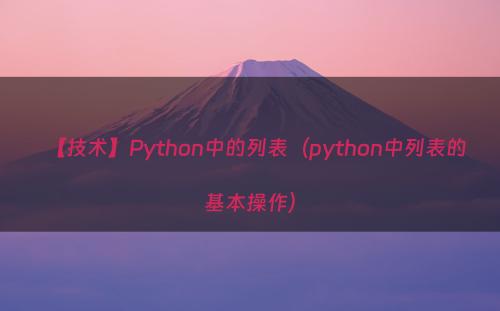1. 理解Python中的列表
1.1 什么是列表?
Python 中的列表是可变的、有序的元素集合。这些元素可以是任何数据类型,并且它们存储在序列中。让我们首先了解列表的基本语法以及如何创建和操作它们。
1.2 创建列表
在 Python 中创建列表非常简单,并且有多种方法可以初始化它们

# Creating a list using square brackets
my_list = [1, 2, 3, 'hello', True]
# Using the list() constructor
another_list = list(range(5))1.3 访问和修改列表元素
访问和修改列表中的元素涉及使用索引。 Python 中的列表是零索引的,这意味着第一个元素的索引为 0
# Accessing list elements
print(my_list[0]) # Output: 1
# Modifying list elements
my_list[3] = 'world'
print(my_list) # Output: [1, 2, 3, 'world', True]1.4 列表方法
Python 列表带有多种内置方法来对其执行操作
# List methods
my_list.append(4) # Appending an element
my_list.extend([5, 6]) # Extending the list
my_list.remove(2) # Removing an element2. 列表操作及最佳实践
2.1 添加和删除元素
了解 append() 、 extend() 和 remove() 等操作以实现高效的列表操作
# Adding and removing elements
my_list.append(7) # Appending a single element
my_list.extend([8, 9]) # Extending with multiple elements
my_list.remove('world') # Removing a specific element2.2 迭代列表
遍历列表是一种常见的操作。了解循环元素的不同方法
# Iterating through a list
for element in my_list:
print(element)2.3 列表推导式
列表推导式提供了一种创建列表的简洁方法
# List comprehension
squared_numbers = [x**2 for x in range(5)]
print(squared_numbers) # Output: [0, 1, 4, 9, 16]3. 高级列表技术
3.1 嵌套列表
列表可以包含其他列表,形成嵌套结构
# Nested lists
matrix = [[1, 2, 3], [4, 5, 6], [7, 8, 9]]
print(matrix[1][2]) # Output: 63.2 列表切片
列表切片允许您有效地提取子列表
# List slicing
subset = my_list[1:4]
print(subset) # Output: [2, 3, 'world']3.3 列表串联
使用 + 运算符组合列表
# List concatenation
combined_list = my_list + [10, 11, 12]
print(combined_list)3.4 列表复制
了解创建列表副本的不同方法
# List copying
shallow_copy = my_list.copy()
deep_copy = my_list[:]4. 性能优化和内存管理
4.1 内存效率
探索在使用列表时优化内存使用的技术
# Memory efficiency
import sys
memory_size = sys.getsizeof(my_list)
print(f"List Size: {memory_size} bytes")4.2 列表操作的时间复杂度
检查常见列表操作的时间复杂度
# Time complexity of list operations
# Access, insertion, and deletion: O(1) on average
# Search: O(n) - linear search5. 实际应用和用例
5.1 数据排序和过滤
列表通常用于排序和过滤数据
# Sorting and filtering
numbers = [4, 2, 8, 1, 5]
sorted_numbers = sorted(numbers)
filtered_numbers = list(filter(lambda x: x > 3, numbers))5.2 栈和队列
使用列表实现堆栈和队列
# Stacks and queues
stack = []
stack.append(1)
stack.append(2)
popped_item = stack.pop()
queue = []
queue.append(1)
queue.append(2)
dequeued_item = queue.pop(0)5.3 动态数组
了解 Python 中的列表如何充当动态数组
# Dynamic arrays
dynamic_array = [None] * 10
dynamic_array[0] = 15.4 列表作为可变序列
利用列表作为可变序列来进行高效的数据操作
# Mutable sequences
sequence = [1, 2, 3, 4, 5]
sequence[2:4] = [10, 20, 30]6. 与其他Python数据结构集成
6.1 列表与元组
比较不同用例的列表和元组
# Lists vs. tuples
# Use lists when elements may need to be modified
# Use tuples for immutable, unchangeable sequences6.2 集合和列表
理解集合和列表之间的关系
# Sets and lists
unique_elements = set(my_list)
print(unique_elements)6.3 字典和列表
集成字典和列表以实现高效的数据表示
# Dictionaries and lists
employee_data = {'name': 'John', 'age': 25, 'skills': ['Python', 'Java']}7. 面向对象编程中的列表
7.1 在列表中存储对象属性
使用列表来存储和管理对象属性
# Storing object properties in a list
class Person:
def __init__(self, name, age):
self.properties = [name, age]
# Creating a Person object
person = Person('Alice', 30)
print(person.properties[0]) # Output: Alice7.2 对象的序列化和反序列化
使用列表进行对象序列化和反序列化
# Serialization and deserialization of objects using lists
class Student:
def __init__(self, name, age, grades):
self.name = name
self.age = age
self.grades = grades
def to_list(self):
return [self.name, self.age, self.grades]
@classmethod
def from_list(cls, data):
return cls(data[0], data[1], data[2])
# Serializing a Student object
student = Student('Bob', 22, [90, 85, 78])
student_list = student.to_list()
# Deserializing a list to a Student object
new_student = Student.from_list(student_list)8. 常见陷阱以及如何避免它们
8.1 可变性和不变性
避免列表中的可变对象引起的意外行为
# Pitfall: Mutability
mutable_element = [1, 2, 3]
my_list = [mutable_element] * 3
mutable_element[0] = 'changed'
print(my_list)8.2 低效运营
识别和优化低效的列表操作
# Pitfall: Inefficient operations
for i in range(len(my_list)):
my_list[i] = my_list[i] * 28.3 意外的副作用
通过避免意外的副作用来确保代码的健壮性
# Pitfall: Unintended side effects
for element in my_list:
if element == 'world':
my_list.remove(element)9. 未来趋势和更新
9.1 Python 列表的最新变化(截至 2022 年)
探索 Python 列表的最新更改和更新
# Recent changes in Python lists (as of 2022)
# (Check Python release notes for the latest updates)9.2 PEP 和列表增强的提案
随时了解正在进行的与列表相关的 Python 增强提案 (PEP)
# PEPs and proposals for list enhancements
# (Check Python PEP repository for the latest proposals)